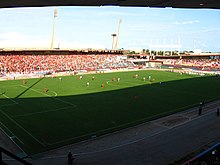Alagoas
Land of the sururu (or Charru Mussel), lagoon shellfish which serves as food for the coastal population, and of coconut water, Alagoas also possesses some of the country's richest folklore.
Thus arose Porto Calvo, Alagoas (now Marechal Deodoro) and Penedo, nuclei which guided the colonization, economic, and social life of the region for a long time.
The escape of African slaves during the Dutch invasion created a serious labour shortage problem on the sugarcane plantations.
At the beginning of the 20th century, the region's hinterland lived through the pioneering experience of Delmiro Gouveia, an entrepreneur from Pernambuco who installed the Estrela thread factory, which came to produce 200 spools daily.
Delmiro Gouveia was killed in October 1917 in circumstances still unclarified, after being pressured, according to rumor, to sell his factory to competing foreign firms.
Initially, in the first years of the 16th century, Alagoas settlement went on slowly, however helped by Africans turned into slaves whose work urged the local economy.
He increased the number of sugar cane plantations and built some sugar mills, as well as founding the cities of Penedo and Alagoas – this last one originally baptized by Portuguese as Santa Maria Madalena da Alagoa do Sul (Saint Mary Magdalene of the Southern Lake), currently the historic heritage town of Deodoro da Fonseca.
In 1570, a second expedition ordered by Duarte Coelho and led by Cristóvão Lins, explored the north of Alagoas and founded the settlement of Porto Calvo and five sugar mills, which two of them still endure, Buenos Aires and Escurial.
Decades before Alagoas was formed in 1817, its sugar industry had 200 mills, and agriculture also involved cotton, tobacco and corn plantations.
In 1839, the capital of the province was changed definitively from the town of Alagoas to Maceió, mainly due to the increasing growth of the city because of its port.
Small to medium-sized tanker ships took alcohol on board in Maceio's port with considerable frequency during the peak period.
Another local industry is based on chemical products from brine pumped from deep wells on the outskirts of Maceió.
The northern coast, particularly around the towns Maragogi and Japaratinga is beginning to see some of this development in the form of resorts attracting people from the south and from Europe.
It includes space for art exhibitions, a panoramic deck, chapel, seven escalators, nine elevators and four boarding bridges.
[citation needed] In the new terminal, Infraero also brings to Maceió "Aeroshopping" – a concept that is transforming the country's airports into centers for leisure and high-quality products and services.
The building is "intelligent", meaning controlled by a computerized system that regulates factors ranging from the lighting level to air temperature and even the speed of the escalators.
The commercial and economic development of the Port of Jaraguá, on the margins of the Mundaú lagoon, was responsible for the emergence of an important settlement that received the name of Maceió and later became the present capital of Alagoas.
There are several football clubs based in the state, such as ASA de Arapiraca, CRB, CSA, Murici, Coruripe, CSE, Santa Rita, Penedense and Ipanema.







